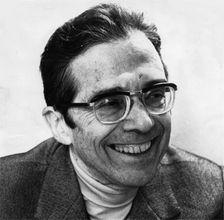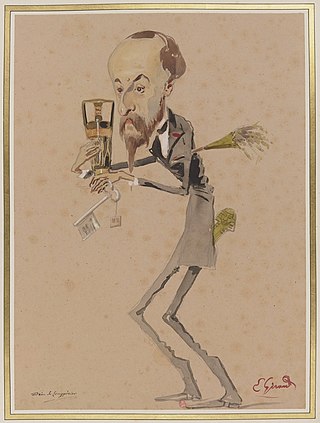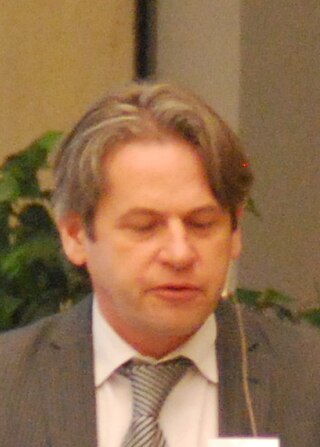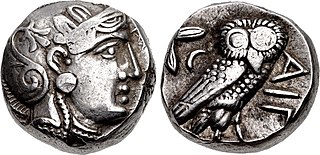Related Research Articles

Henri Curiel was a left-wing political activist in Egypt and France. Born in Egypt, Curiel led the communist Democratic Movement for National Liberation until he was expelled from the country in 1950.

Montricoux is a commune in the Tarn-et-Garonne department in the Occitanie region in southern France. It is located along the banks of the Aveyron, between Nègrepelisse and Bruniquel. The written history of the commune dates back to the eighth century. The Château de Montricoux, built by the Knights Templar, now houses the Marcel-Lenoir Museum, which preserves 130 drawings, pastels, watercolors, oils, and frescoes by this artist, a resident of the town.
Henri Arnold Seyrig was a French archaeologist, numismatist, and historian. He was the general director of antiquities of Syria and Lebanon since 1929, and director, for more than twenty years, of the Institute of Archaeology of Beirut.
Abbé Jean Starcky was a French priest who was one of the early editors of the Dead Sea Scrolls. He studied at the Pontifical Biblical Institute in Rome and the École Biblique et Archéologique Française in Jerusalem. As a specialist in Palmyrene Aramaic and Nabataean texts he joined the international Dead Sea Scrolls team in January 1954.

Alain Gresh is a French communist party leader and journalist.

Henry Adrien Prévost de Longpérier was a 19th-century French numismatist, archaeologist and curator.
Gaston Wiet was a 20th-century French orientalist.

François de Callataÿ is a Belgian ancient historian, professor at the École pratique des hautes études (Paris/Sorbonne), who has written significant studies of coinage and finance in the ancient Mediterranean world.
Michel Christol is a French historian, specialist of ancient Rome, and particularly epigraphy.
Jean Andreau is a French historian, former student of the École normale supérieure (1960) and former member of the École française de Rome. As of 2016, he is research director at the EHESS.
Olivier Picard was a French archeologist. He was director of the French School at Athens and a member of the Institut de France.
Georges Charles Le Rider was a French historian, librarian and administrator, a specialist in Greek numismatics, who headed the Bibliothèque nationale de France in Paris. He had a filial relationship with Henri Arnold Seyrig who became and remained his mentor.

The Kabul hoard, also called the Chaman Hazouri, Chaman Hazouri or Tchamani-i Hazouri hoard, is a coin hoard discovered in the vicinity of Kabul, Afghanistan in 1933. The collection contained numerous Achaemenid coins as well as many Greek coins from the 5th and 4th centuries BCE. Approximately one thousand coins were counted in the hoard. The deposit of the hoard is dated to approximately 380 BCE, as this is the probable date of the least ancient datable coin found in the hoard.
François Thierry de Crussol, known by his Chinese name 蒂埃里, is a French numismatist, specialising in East Asian currency.
Bruno Dagens is a French archaeologist, art historian, Sanskritist, and a specialist on Angkor Wat. He is currently a professor emeritus of the University of Sorbonne Nouvelle Paris 3.
Claude Rapin is an archaeologist and historian specializing in Central Asia, with special attention to Afghanistan and Uzbekistan. He is Director Emeritus for research at the Centre national de la recherche scientifique (CNRS) and is associated with the Mission archéologique franco-ouzbèke de Sogdiane.
Cécile Morrisson is a French historian and numismatist. She is Director of Research emeritus at the French National Center for Scientific Research and specializes in the study of the Byzantine Empire.
The French Archaeological Delegation in Afghanistan was created in France in 1922 at the request of the Afghan government and King Amanullah Khan to commence archaeological studies in Afghanistan. After a break in research during the Second World War, work resumed around 1946-47, until it was closed by the pro-Soviet Afghan government on December 15, 1982. Some notable 20th century French archaeologists who were part of the delegation include Jules Barthoux, Daniel Schlumberger, and Paul Bernard.

Josette Elayi-Escaich is a French antiquity historian, Phoenician and Near-Eastern history specialist, and honorary scholar at the French National Center for Scientific Research (CNRS). Elayi authored numerous archaeology and history works, and literary novels. She is well known to the French public through her novels and for her calls for reform and activism against the CNRS research policy bias. In 2007 Elayi was decorated Knight of the Legion of Honor by the French state.
Georges Colonna Ceccaldi was a French antiquities dealer and diplomat.
References
- 1 2 "CURIEL, Raoul – Persons of Indian Studies by Prof. Dr. Klaus Karttunen". 13 June 2020. Retrieved 2020-08-13.
- ↑ "Raoul Curiel". Le Monde.fr (in French). 2000-02-25. Retrieved 2020-08-13.
- ↑ Don LaCoss (Spring 2010). "Egyptian Surrealism and "Degenerate Art" in 1939?". The Arab Studies Journal. 18 (1): 105. JSTOR 27934079.
- ↑ "Curiel, Raoul – Persée". www.persee.fr. Retrieved 2020-08-13.
- ↑ "Collections Online | British Museum". www.britishmuseum.org. Retrieved 2020-08-13.
- ↑ "Curiel" – via BnF Catalogue général (http://catalogue.bnf.fr).
- ↑ Christie, Anthony (February 1957). "Raoul Curiel and Daniel Schlumberger: Tréors monétaires d'Afghanistan. (Mémoires de la Délégation Archéologique Française en Afghanistan, Tom. XIV.) [x], 131 pp., 16 plates. Paris: Imprimerie Nationale, 1953". Bulletin of the School of Oriental and African Studies. 19 (1): 183–184. doi:10.1017/S0041977X0011941X. ISSN 1474-0699. S2CID 161806937.
- ↑ Ball, Warwick (2019-05-02). Archaeological Gazetteer of Afghanistan: Revised Edition. Oxford University Press. ISBN 978-0-19-927758-2.
- ↑ Gyselen, Rika; Curiel, Raoul (1984). iraniennes, Association pour l'avancement des études (ed.). Une Collection de monnaies de cuivre arabo-sasanides. Studia Iranica. Cahiers. Vol. 2.
- ↑ "Author Search Results". klgrid.kmlink.com.my. Retrieved 2020-10-28.